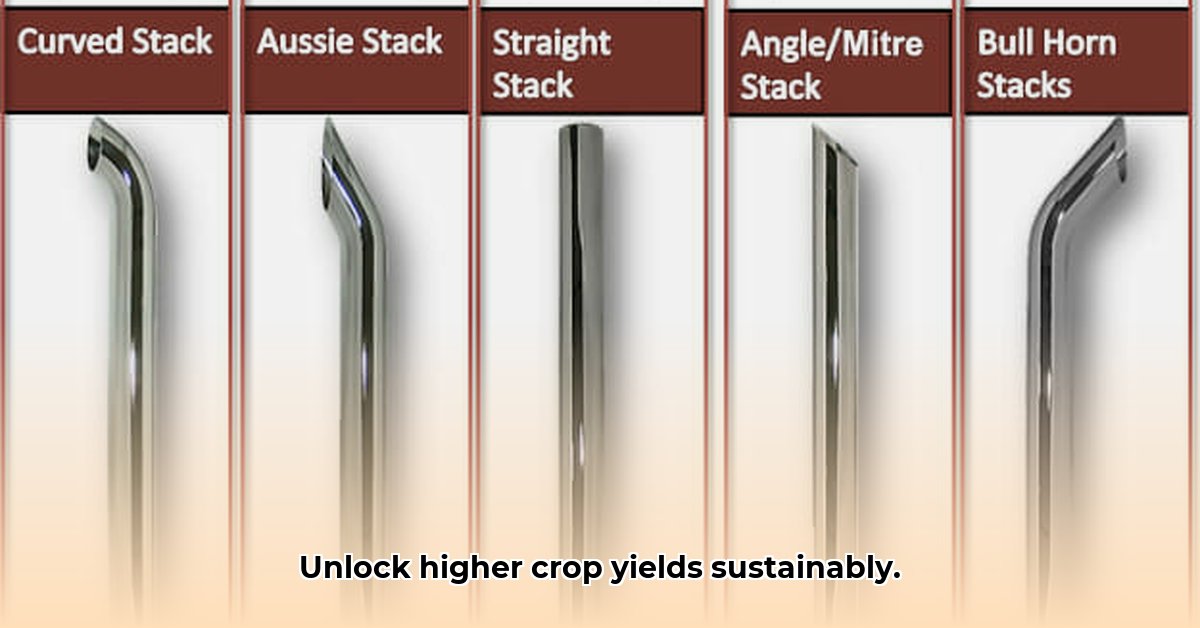
Want to revolutionize your farm's efficiency and environmental footprint? This guide explains how chrome stacks—advanced sensor and data analysis systems for tractors—can significantly improve your sustainable farming practices. We'll cover what they are, how they work, their advantages, potential challenges, and a step-by-step implementation plan. For more on tractor costs, check out this resource.
Understanding Chrome Stacks: Smart Technology for Sustainable Farming
Chrome stacks represent a significant leap forward in precision agriculture. They aren't just a single piece of equipment but a comprehensive system integrating sensors, software, and data analytics to optimize your tractor's performance and resource management. Think of it as giving your tractor a "brain" that constantly monitors and adapts to changing conditions. This network collects real-time data on various factors, including soil moisture, nutrient levels, plant health, and weather patterns. This information is then used to optimize operations, reducing waste and maximizing yields.
How significant are these improvements? Studies show that precision agriculture techniques, including those using similar technologies, can lead to a 10-20% increase in yield while reducing water and fertilizer use by up to 30%. Is this a game-changer for your farm's sustainability?
How Chrome Stacks Work: From Data Collection to Actionable Insights
Here's a breakdown of the chrome stacks process:
Data Acquisition: Sensors mounted on your tractor and strategically placed throughout your fields collect comprehensive data. This includes soil moisture levels (measured in volumetric water content), nutrient concentrations (measured in parts per million), temperature, and even plant health indicators like chlorophyll levels.
Data Transmission: Collected data is transmitted wirelessly (often via cellular or satellite networks) to a cloud-based platform or on-farm server. This allows for centralized data storage and analysis.
Data Analysis: Powerful algorithms process the raw data, identifying patterns and trends, and generating actionable insights. For example, the system might highlight areas requiring additional irrigation, targeted fertilizer application, or pest control.
Decision Support: The platform provides farmers with user-friendly dashboards displaying key performance indicators (KPIs) and suggesting optimized actions. This could involve adjusting irrigation schedules, variable rate fertilizer application, or targeted pesticide use.
Adaptive Learning: The system constantly learns and refines its recommendations based on real-world results, ensuring continuous improvement over time. This iterative feedback loop is crucial for optimizing performance.
The Advantages of Chrome Stacks: Maximizing Efficiency and Sustainability
Implementing chrome stacks offers numerous benefits:
Resource Optimization: Reduce water and fertilizer usage by up to 30%, saving costs and minimizing environmental impact. This translates directly into cost savings and reduced environmental burden. Isn't that a compelling reason to consider adoption?
Yield Enhancement: Precise resource management leads to significant yield improvements (studies show 10-20% increases are possible) by creating optimal growing conditions. This directly impacts your farm's profitability.
Environmental Stewardship: Minimize your farm's carbon footprint by reducing resource consumption and optimizing practices. This aligns with growing consumer demand for sustainably produced food.
Labor Efficiency: Automate various tasks, freeing up valuable time for other crucial farm management activities. Isn't streamlining labor processes essential for modern, thriving farms?
Data-Driven Decision Making: Move beyond guesswork and intuition; let data guide your decisions for improved efficiency and profitability. This evidence-based approach is the future of sustainable agriculture.
Potential Challenges and Mitigation Strategies
While chrome stacks offer compelling advantages, potential challenges include:
| Challenge | Mitigation Strategy |
|---|---|
| High Initial Investment | Explore leasing options, government grants, or cooperative purchasing models. |
| Data Security Concerns | Choose reputable providers with robust security protocols and data encryption. |
| Required Technical Expertise | Opt for systems with user-friendly interfaces and readily available training and support. |
| System Integration | Verify compatibility with existing farm equipment and software before implementation. |
| Data Overload | Focus on key KPIs through customized dashboards and reporting tools. |
Implementing Chrome Stacks: A Step-by-Step Guide
Successfully integrating chrome stacks requires careful planning and execution:
Needs Assessment: Analyze your farm's specific requirements, considering crop types, soil conditions, and existing infrastructure.
System Selection: Choose a system compatible with your needs and budget, considering factors like sensor density, data processing capabilities, and software integration.
Professional Installation: Expert installation is typically recommended to ensure optimal functionality and data accuracy.
Training and Support: Invest in staff training and ongoing support to maximize system utilization and understand data interpretation.
Data Integration and Monitoring: Integrate the system with your existing farm management software and establish a routine of data monitoring and analysis.
Optimization and Adjustment: Continuous monitoring is crucial. Adapt system settings based on data analysis and observed results.
Conclusion: Embracing the Future of Sustainable Farming
Chrome stacks represent a powerful tool for optimizing sustainable farming practices. While initial investment might be significant, the long-term benefits in terms of resource efficiency, yield enhancement, and environmental sustainability often outweigh the costs. By embracing this technology, farmers can position themselves for success in a rapidly evolving agricultural landscape. The future of farming is smart, and chrome stacks are leading the way. Are you ready to join the revolution?